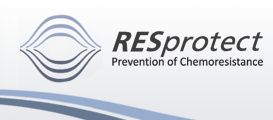| Prevention of adriamycin-induced mdrl gene amplification and expression |

|

|

|
Page 6 of 7
The effectiveness of DNA replication or repair of DNA damage depends on a balanced supply of deoxyribonucleoside triphosphate (dNTP) precursors of DNA. Should cellular dNTP levels be perturbed, a wide range of genetic events may follow due to aberrant DNA replication or repair. For example, manifestations of DNA precursor imbalance can include gene mutation; recombination; enhanced sensitivity to mutagens/carcinogens (i.e. co-mutagenic and co-carcinogenic effects); chromosome breakage, exchange or loss (Haynes, 1985; Kunz et al., 1994). Therefore, thinking about the mode of action of 5-substituted pyrimidine nucleoside analogs, possible changes in nucleotide pools have to be taken into account. It seems evident that for the repair of cytostatica induced DNA-damage this pool could be very important, and that the addition of 5-substituted pyrimidine nucleoside analogs could cause modifications not only in the available pools but also by changing the fidelity of certain polymerases. Such changes could influence recombination as well as gene amplification. Theoretically it is possible that BVDU, by disrupting nucleotide pools or by inhibiting key enzymes, might act as general inhibitor of DNA repair. As such, inhibition of recombination may be only one outcome. BVDU may also act to increase the cytotoxicity of chemotherapeutic agents by blocking repair of induced DNA lesions. To demonstrate that BVDU does not simply act as a general inhibitor of DNA repair just increasing the cytotoxicity of adriamycin by blocking repair of adriamycin induced DNA lesions, F4-6-wt sensitive cells were treated for 72 hours with up to 25 ng/ml adriamycin alone or with adriamycin + 1 µg/ml BVDU. It can be seen in Fig. 1 C and table 1 in respect to the IC50 that BVDU did not enhance the effect of adriamycin. In contrary, the toxic effect of adriamycin seems to be lowered. This reduction of toxicity could also be observed in vivo: tumor bearing rats treated with adriamycin alone showed at longer treatment times a strong loss of body weight. Rats treated with adriamycin (3 x 4 mg/kg per week) + BVDU (5 x 15 mg/kg per week) showed an increase in body weight and decrease in tumor weight (unpublished results). Drugs that reverse MDR have been shown to inhibit the P-glycoprotein-mediated drug efflux mechanism (Ford & Hait, 1990). Therefore, another question was, if it is perhaps possible to circumvent multidrug resistance by treatment of resistant tumor cells (overexpressing the mdr-gene) with BVDU. F4-6 cells (resistant to 20 ng/ml adriamycin), collected at the end of the 4 week experiment, were treated for 72 hours with 35 ng/ml adriamycin alone, or with adriamycin + 1 µg/ml BVDU. It is apparent (table 1) that BVDU did not influence the effect of adriamycin. The IC50 was similar for both treatments. Although not directly proven, virtually all proposed mechanisms for gene amplification involve recombination (Schimke et al., 1986; Volkert & Broach, 1986; Wahl, 1989). In fact, it is difficult to think of any model for gene amplification that would not involve recombination. Therefore, it was of interest to see if the anti-recombinogenic effect of BVDU in yeast (Fahrig, 1996) that had been confirmed by the anti-amplification effect on SV40 DNA in Chinese hamster cells (Fahrig & Steinkamp-Zucht, 1996) could be observed also in a relevant mammalian gene. As this was the result of our study, the idea is supported that gene amplification is mechanistically related to recombination. In contrast to those drugs used for reducing the function of P-glycoprotein, the action of BVDU is directed against the mechanism of resistance, i.e., amplification of several target genes may be attacked by which many neoplastic cells develop resistance to anticancer drugs. We have shown that mdr-gene amplification and expression could be detected in adriamycin treated and resistant cells in vitro, underlining the hypothesis that gene amplification is part of the mechanism how these cells gain resistance against antineoplastic drugs. Chronic treatment with antineoplasic drugs does not only lead to amplification of the mdr-gene, but also to the overexpression and amplification of certain oncogenes controlling resistance to this treatment. The results of Bhushan et al. (Bhushan et al., 1992) are consistent with the hypothesis that induction of c-fos by low levels of cytotoxic drugs may be an early event in the acquisition of the MDR phenotype. Furthermore, Bhuschan et al. (1996) could show that enhanced expression of the c-fos gene preceded the expression of the mdr3 gene. In MDR sublines of both murine sarcoma and human KB-3-1 carcinoma cell lines, the expression of c-fos and c-jun increased as drug resistance increased. Nakagawara et al. (1990) found an inverse correlation between expression of amplified N-myc and the expression of mdr1 in the same human neuroblastoma tumor samples. Neuroblastoma with N-myc amplification no longer responded to chemotherapy. Bordow et al. (1994) and Norris et al. (1996) observed that expression of the multidrug resistance-associated membrane-bound glycoprotein (MRP) gene correlated with amplification and overexpression of the N-myc oncogene in childhood neuroblastoma, which is central to the malignant phenotype of this disease. Therefore, gene amplification may be a central mechanism in acquiring chemoresistance. Our in vitro study with adriamycin + BVDU has been reconfirmed in vivo in our laboratory and in an industrial laboratory. BVDU inhibited at plasma levels that were similar to those in the in vitro-experiments adriamycin-induced amplification and expression of the mdr-1 gene in tumors of rats in vivo. Through this inhibition of gene amplification, BVDU strongly enhanced the effects of adriamycin in suppressing the growth of fibrosarcomas, mammary adenocarcinomas and Ah13 sarcomas. At present we examine the effects of BVDU in vivo in combination with different cytostatic drugs. Resistance against these drugs has to do with amplification/expression of other genes than the mdr1 gene.
|
|||||||||


